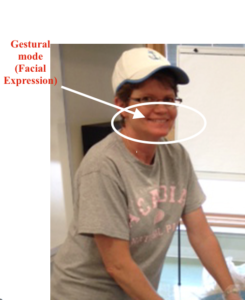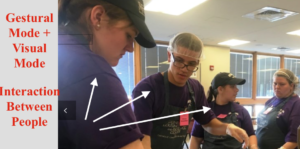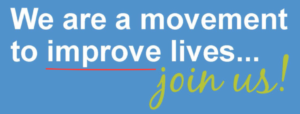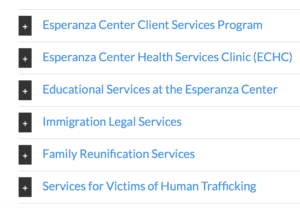The Esperanza Center is a nonprofit organization located in Baltimore, Maryland. The organization serves to improve the lives of immigrants by offering educational, legal, and compassionate services. Below we will review a rhetorical analysis that describes the audience, purpose, context, author, and genre pertaining to the Esperanza Center.
Audience
The Esperanza center primary target audience are individuals who value giving back to the community by donating money or volunteering. The writer appeals to the values of the primary audience by using a slideshow of visual modes on the volunteer page. In the images, a gestural mode is displayed through facial expressions and interactions between people to emphasize that “Serving people of all ages, we can help you find your place to make a difference”(“Esperanza Center”, n.d.)


The secondary audience, are individuals who are seeking to find immediate help, members of Catholic communities in Maryland, someone looking for employment, and competitors interested in developing a nonprofit. The values the secondary audience are diverse. Some individuals desire a company that will help in career development, where others are looking for a specific program for a loved one. The writer appeals to the secondary audience through spatial mode. Readers can easily access the information they are looking for through the organization of paragraphs, and Z shaped page layout.
Purpose
The overall intention of the Catholic charities website is to improve the lives of the community. On the display page of the website, the writers wrote in big white text “We are a movement to improve lives, join us”(“Esperanza Center,” n.d.). Executive director, Bill Mccarthy wrote, the organization aspires to “touch the lives of hundreds of thousands of individuals and families each year”(“About Us,” n.d.). With that being said, the purpose of the Esperanza center is to specifically cater to immigrant families. The center assists in offering educational services, health services, legal services, reunification services, and human trafficking services. The secondary intention of this website is to publicize the positive impact Catholic churches have on the community. This is shown on the homepage through video media, news, stories, and testimonials.


Context
The medium is executed through a website. The writer chose a website because the organization is able to communicate their services and mission to a large demographic of people at a low cost. In addition, many organizations feel that individuals prefer to access information through the internet rather than a newspaper or brochure because technology is easily accessible. Readers are able to interact with this text via tablet, phone, desktop, or laptop. Esperanza’s website is multimodal. The writer communicates information through various modes such as words, pictures, videos, bullet points, colors, shapes, and paragraph spacing. One does not have to sit down to understand the message the writer is trying to convey. The physical arrangement of the website is organized for readers to obtain the information they need by reading the large fonts and clicking the headings.


Author
I believe the writer or writers of this website are the employees that handle the media and content creation for the organization. Bill McCarthy, who is the executive director for the organization is the only staff member whose name is attached to the content on the website. I do not believe he is solely responsible for all the media within the website. However, he is responsible for many articles that are written on the company’s blog. The anonymous writer or writers have established credibility in the website by highlighting the competing organizations that recognized them for their impact of the community. The writer includes data such as annual reports for donors to view where assets are being used in the organization. Also, the media on the website are pictures of volunteers working at events, and the videos contain interviews by staff members that currently work in the organization.
Genre
The genre of this website is a nonprofit organization. Esperanza center’s website spatial mode is arranged in a template format thats similar to other nonprofits websites such as the National Alliance to End Homelessness. Both websites contain the standard donate page, about us page, events page, news page, contact information, search engine, and the organization’s name in the top header. Both websites feature compelling images that bring awareness to the cause. A more specific genre that demonstrates the website’s genre is a message board/ weblog/ directory styled website. The home page is one message for the masses. The weblog features articles for readers to interact with the organization. The directory allows readers to examine information with ease.


References
“Esperanza Center.” Catholic Charities of Baltimore, www.catholiccharities-md.org/services/esperanza-center/.
MCcarthy , Bill. “About Us.” Catholic Charities of Baltimore, www.catholiccharities-md.org/about-us/.